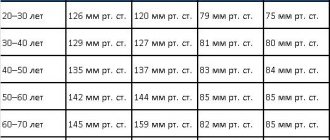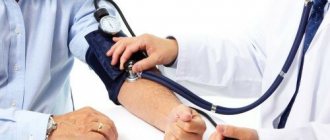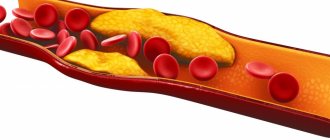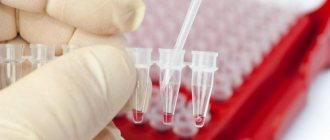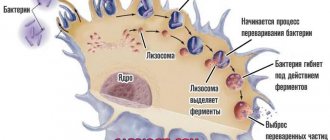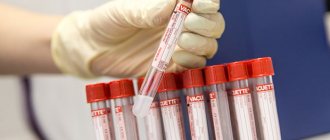The pulse can tell whether a person has any disease and help identify problems with the heart. Anyone can determine the frequency of beats. To do this, it is enough to have basic skills and basic knowledge of counting.
The heart rate in adults must be within certain limits (norms), deviation from which is grounds for visiting a doctor. You cannot diagnose yourself and self-medicate.
Today we will talk about the normal pulse rate in men and what a deviation from these norms indicates.
What is pulse
Pulse is a jerky oscillation of the walls of blood vessels that occurs as a result of the flow of blood after it is expelled from the cardiac cavities and enters the large main and then peripheral arteries.
The nature of the pulse wave propagation and the number of its repetitions depends on the cardiac cycle, due to which, when indicators change, disorders in the human body are judged. Unlike the heart rate (HR), which reflects only the number of heart beats in one minute, the pulse shows the number of waves and impulses occurring in the arteries in the same unit of time. Pulse diagnostics are widely used in modern medicine. In addition to the traditional manual method of determination by palpation on the radial, carotid, femoral or temporal artery, a hardware examination is carried out. To do this, use a pulse oximeter, heart rate monitor or electrocardiograph, each of which helps to anticipate the number of wave oscillations per minute.
What should an adult man's pulse be?
Pulse is the number of rhythmic vibrations of the walls of the arteries and vessels of the body associated with the work of the heart muscle to circulate blood in the body over a given period of time. Simply put, this is the number of heart beats in one minute. Determining heart rate (HR) is necessary to monitor the activity of the heart and detect problems in its functioning.
In an adult man, the normal heart rate (HR) is 60-70 beats per minute. General indicators for humans allow a maximum rate of 80 blows.
Main factors influencing heart rate:
- gender of the person (pulse rates in women are higher than in men);
- age (in children the heart rate is higher than in adults);
- height (in a tall person, the heart beats less often);
- physical condition (an athlete’s resting heart rate is lower than that of an ordinary person);
- time of day (heart rate is reduced during night sleep, as well as for an hour before and after it).
Table by age
A person’s pulse rate depends on the environment, overall health and psycho-emotional balance. Below is a list of factors that influence the value of this indicator:
- gender - in men, the pulse rate is on average 5-8 beats per minute less than in women. This is due to the anatomical features of the structure of the heart: due to the large size of the heart muscle, the required volume of blood is pumped in fewer contractions;
- environment - in the hot season, under the influence of hot temperatures, the heartbeat increases, in cold climates it becomes slower, since the speed of blood flow decreases. Psycho-emotional or physical stress provokes an increase in heart rate within the upper limits of normal;
- posture – in a horizontal position the wave number is weaker than in a vertical position. This occurs due to slowing blood flow and reducing the load on the heart;
- provoking factors - with an increase in body temperature by more than one degree against the background of an infectious, viral disease or prolonged exposure to the sun, the pulse quickens by 10 or more beats per minute. Physical activity also affects this indicator. Walking, running or squats increase heart rate and the number of pulse oscillations to 120-140 in an adult;
- age – the normal heart rate by age depends on the characteristics of the development and functioning of the cardiovascular system. For example, in newborns, due to the smaller size of the heart and lungs, the distinctive characteristics of breathing after birth and the restructuring of the circulatory system, the pulse significantly exceeds the norm for an adult. In older age, the cause is neurocirculatory dystonia, which occurs when the functioning of the autonomic nervous system is disrupted. Normally, by the age of 15-18, a teenager has a pulse of 60-80 beats.
Below is a table of heart rate norms by age in adults and children:
| Period, age | Minimum/maximum heart rate per minute | Average value |
| Newborn baby (up to 4 weeks) | 140/170 | 140 |
| Infant, 1-6 months | 130/160 | 140 |
| 6-12 months | 120/140 | 130 |
| 2-3 years | 110/150 | 120 |
| 3-6 years | 100/130 | 110 |
| 6-8 years | 80/120 | 90-100 |
| 10-12 years | 70/110 | 90-100 |
| 12-14 years old | 70/100 | 90 |
| 14-16 years old | 60/90 | 70-80 |
| 16-18 years old | 60/85 | 75 |
| 18-30 years old | 60/80 | 70 |
| 30-40 years | 65/85 | 75 |
| 40-50 years | 70/90 | 80 |
| 50-60 years | 75/95 | 80-85 |
| 60-70, over 70 years old | 80/95 | 90 |
Normal human heart rate by age - table of men and women
Pulse rate is an important indicator in assessing heart function. Its determination is a component in the diagnosis of arrhythmia and other diseases, sometimes quite serious. WHAT IS PULSE? The pulse is the vibration of the vascular walls that occurs as a result of contractions of the heart muscles. This indicator allows you to evaluate not only the strength and rhythm of the heartbeat, but also the condition of the blood vessels. In a healthy person, the intervals between pulsations should be the same, but the unevenness of heartbeats is regarded as a symptom of disorders in the body - this can be either a heart pathology or another disease, for example, a malfunction of the endocrine glands. Pulse is measured by the number of pulse waves, or beats, per minute and has certain values - in adults it is from 60 to 90 at rest. HOW IS THE PULSE MEASURED? The pulse is measured by the beats of pulsating blood in the radial artery, most often on the inside of the wrist, since the vessel in this place is located closest to the skin. For greatest accuracy, the indicators are recorded on both hands. If there are no rhythm disturbances, then it is enough to count the pulse for 30 seconds and multiply it by two. If the heart beats are irregular, then it is more advisable to count the number of pulse waves in a whole minute. In more rare cases, counting is carried out in places where other arteries pass - brachial, femoral, subclavian. You can measure your pulse by placing your fingers on your neck at the site of the carotid artery or on your temple. If a thorough diagnosis is necessary, for example, if serious diseases are suspected, then other examinations are performed to measure the pulse - Voltaire mount (counting per day), ECG. The so-called treadmill test is also used, when the work of the heart and blood pulsation are recorded by an electrocardiograph while the patient moves on a treadmill. This test also shows how quickly the functioning of the heart and blood vessels returns to normal after physical activity. WHAT AFFECTS PULSE VALUES? If the normal heart rate in women and men at rest remains within the range of 60-90, then for many reasons it may temporarily increase or acquire slightly increased constant values. This is affected by age, physical activity, food intake, changes in body position, temperature and other environmental factors, stress, and the release of hormones into the blood. The number of pulse waves occurring per minute always depends on the number of heart contractions (abbr. HR) during the same time. Typically, the normal pulse rate in men is 5-8 beats lower than in women (60-70 per minute). Normal indicators differ in children and adults, for example, in a newborn child, a pulse of 140 beats is considered normal, but for an adult this is tachycardia, which can be either a temporary functional state or a sign of a disease of the heart or other organs. Heart rate also depends on daily biorhythms and is highest between 15:00 and 20:00.
TABLE OF PULSE RATES BY AGE IN WOMEN AND MEN
Characteristics
When studying the pulse, the following indicators are assessed:
- symmetry on the vessels of the same name on opposite sides of the body;
- rhythm of pulse waves;
- frequency per minute or equal periods of time;
- tension, resistance;
- fullness;
- average value;
- ripple waveform;
- the presence or absence of a deficit between heart rate and pulse.
What does each of these criteria mean? The following are the characteristics with explanations:
- Symmetry - assessment of pulse fluctuations in the vessels of the same name in different halves of the body (on the radial arteries of the arms or carotid arteries on both sides of the neck). With a normal pulse, there are no differences in time interval, size or strength. The exception is when the patient has an injury to the upper or lower extremity, a scar or scar in the palpable area, swelling of this area, or changes in the lymph nodes on the corresponding side.
- Rhythm is the time interval between the sensation of pulse waves. Normally it should be the same. If the difference is noticeable, they speak of an arrhythmic pulse and heart rate. In differential diagnosis, the state of respiratory arrhythmia is taken into account, during which the heartbeat evens out during inhalation and air retention. Another reason for rhythm disturbances: single or multiple extrasystoles, blockades with episodes of interruption in the pulse, incoming attacks of paroxysmal tachycardia, a dangerous form of fibrillation or flutter of the atria/ventricles of the heart, which requires mandatory treatment.
- Frequency per unit of time is the number of pulse beats per minute. With a regular, correct rhythm, they count in 15 seconds and multiply the data obtained by 4, for the total - in 60 seconds. When palpating an irregular pulse, take into account the number of waves per minute without interruption. Normally, in an adult, it ranges from 60 to 80 beats at rest and 90-120 under load. Compare the results obtained using the table, which shows the criteria for each age group. Pathology is indicated by a significant excess of the upper and lower limits of the norm. Pulse less than 40-30/min. in an adult - a sign of complete heart block, weakness of the sinus node, or poisoning with medications or narcotic drugs. Speed up more than 120/min. characteristic of endocrine pathology, serious heart rhythm disturbances or taking stimulant substances/medicines.
- Tension is an indicator of the resistance of the arterial wall under the blood flow at the moment the vessel is pressed with fingers for counting. There is a relationship between the level of systemic pressure and the severity of fluctuations - the higher it is, the stronger the tension is felt and the greater the force required to press the artery until the pulse wave disappears. Experts distinguish three degrees, when the pulse is soft, normal or hard, which often indicates hypertension.
- Fullness - this indicator reflects fluctuations of the arterial wall under the influence of blood flow from the cavities of the heart to the periphery. To measure, the doctor presses the vessel with three fingers and changes the position and pressure of the hand until the extreme degree of decrease and then the greatest resistance is felt. A normal human pulse is of satisfactory filling. With a weak alternation of oscillations, they speak of an empty or intermittent pulse as a consequence of blood loss, shock, injury, congenital or acquired heart disease.
- is determined by the filling and voltage of the pulse waves . The indicator depends on cardiac activity, the change in cycles of systole, when the arteries expand and fill, and diastole, during which the vessels collapse. This value is influenced by the degree of vibration of the walls and their ability to stretch. In elderly patients with atherosclerosis or pathology of the valve apparatus, vascular tone is reduced, which is manifested by less compliance of the arteries and a higher pulse. With slow cardiac activity against the background of progressive cardiac failure, reduced blood volume and slight fluctuations, the pulse decreases.
- The shape of the pulse wave depends on the speed of the heart rate, the time during which blood is expelled from the left ventricle, the degree of arterial resistance, and venous outflow. If the function of the heart valves is preserved, if there is no cardiac congestive pathology, it does not change. To determine, the doctor presses the artery with his fingers and tries to feel the rate of increase in the pulse wave. After which it makes a conclusion about whether a person’s pulse is high or low/small.
- Pulse deficiency is a condition when the frequency of pulse fluctuations differs from the number of heart beats. Or weak waves are not tactilely detected when an artery is pressed on the arm or neck, against the background of rhythmic contractility of the organ, heard during auscultation. The disorder occurs more often with extrasystole or atrial fibrillation, fibrillation.
Features in men and women
An important factor that is taken into account when making a verdict about the normal or pathological pulse is the gender of the person. Due to anatomical and physiological characteristics, the number of pulse oscillations per minute differs, which is due to:
- Different heart sizes . In men, the size of the heart cavities is slightly larger, due to which a larger volume of blood is expelled into the great vessels in one minute and fewer contractions are required for this. Normally, women's pulse is 7-10 beats faster. The exception is professional athletes, who, due to constant training and frequent exercise, develop compensatory bradycardia and the indicator is equal to the norms of men.
- Hormonal imbalance can provoke changes in heart rate in women as they age. Pregnancy, especially in the second and third trimester, physiologically represents a significantly increased load on the cardiovascular system and the entire body, which is manifested by an increased heart rate and, as a consequence, a frequent pulse rhythm. During menopause and menopause, an imbalance of estrogen, progesterone, luteinizing and follicle-stimulating hormone occurs, which has a provoking effect on the cardiovascular system. Symptoms of hot flashes, nervousness, and sleep disturbances appear.
- Frequent, heavy menstruation with loss of a larger volume of blood is the cause of anemia, the main symptom of which is rapid heartbeat and pulse.
- Mental characteristics , susceptibility to frequent mood swings and experiences in the fairer sex are more pronounced, which is manifested by changes in pulse during stress. In men, the provoking factor is often physical activity, overwork due to lack of rest and sleep, or caffeine/alcohol consumption. Another cause of tachycardia or bradycardia is vegetative-vascular dystonia, in which a disorder of the nervous system manifests itself as a more frequent or rare pulse.
- Another indicator that should be taken into account when assessing heart rate norms is body weight . Anatomically, an increase in the load on the heart and the need to deliver blood to a larger area of cells, tissues and muscles requires an increase in heart rate and, as a result, a more frequent pulse rate. Therefore, individuals with obesity and concomitant hypertension have an extremely high risk of developing cardiac complications.
Tachycardia and bradycardia
When the pulse rate changes up or down, they speak of a rhythm disturbance. Tachycardia is an increase in the number of heart contractions over 90-100 beats per minute. It can be physiological, occurring in response to a provoking factor, or pathological. In the first case, a rapid pulse is caused by stress, increased ambient temperature, physical activity, hard work or psycho-emotional experiences. If your heartbeat is normal at rest, there is nothing to worry about. Sometimes an increase in rhythm is provoked by eating, drinking caffeine-containing drinks or alcohol, since such factors are an external irritant for the human body.
The pathological form of tachycardia has no connection with the above reasons, which indicates a cardiovascular disease, an endocrine disorder or concomitant pathology. Often observed in persons with congenital or acquired heart defects, with hypertension, angina pectoris, thyrotoxic crisis or after bleeding. In this case, it is a symptom of the disease.
Bradycardia is a slow heart rate of less than 60 per minute. Normally, it can only manifest itself in physically trained individuals, professional athletes who exercise regularly and for a long time. Pathological indicates a heart rhythm disturbance, atrioventricular block, weakness of the sinus node or a complication of coronary artery disease (CHD), a consequence of a heart attack, intoxication, or valvular disease. In both cases, an examination is required to identify the causes of the disorder and treatment by a specialist.
What should a person's pulse be?
04.10.2021
Every person knows what a pulse is. Most people also know that the normal heart rate is 68-72 beats per minute. However, adjustments should be made here for age and other individual characteristics of the human body. For example, the heart rate of a small child is 2 times higher than that of an adult.
How to measure pulse correctly?
First of all, before you start measuring your heart rate, you should consider the time of day. So, its lowest readings will be observed early in the morning and late in the evening. But at the same time, in the evening (after work) the heart rate is highest.
Also pay attention to the position in which you measure your pulse. If you do this lying down or standing, then its value will be an order of magnitude lower than normal.
To measure your pulse, it is not necessary to count the beats for 1 minute. It is enough to do this for 30 seconds, and then multiply the resulting value by 2.
Do not measure pulse:
- after eating or drinking alcohol;
- on empty stomach ;
- after physical or mental stress, massage , bath, sauna and sexual intercourse;
- after exposure to frost or sun;
- on menstruation days in women;
- with lack of sleep;
- during systemic illness.
If you measure your pulse in the presence of one of the above readings, then its value will not be entirely correct, and then it will be inappropriate to judge any deviation in health.
Low heart rate and its causes
If you regularly measured your pulse (at the same time) and came to the conclusion that your pulse is low, then you need to deal with this situation. Below is a list of possible reasons.
Predisposing factors:
- physiological. Here we need to talk about the fact that some people have a constantly low heart rate, and at the same time they feel quite normal. However, it is still important to be examined for the presence of heart in order to exclude them;
- pathological bradycardia, the cause of which is a disruption of the conduction system of the heart ;
- organic heart : ischemic ( coronary heart disease ), atherosclerosis of the coronary vessels , myocarditis ;
- endocrine disorders;
- diseases of the nervous system , stress;
- intoxication;
- infections;
- increased intracranial pressure;
- taking certain medications.
Do not forget that measuring your heart rate is inextricably linked with the process of measuring blood pressure.
Often it is low blood pressure that leads to a low heart rate. Therefore, medications aimed at increasing blood pressure will help you here. But they should be selected exclusively by the attending physician - self-medication is unacceptable.
If we consider folk remedies, then tonic drinks, for example, green or black tea with ginger, and natural coffee, have proven themselves well.
Guarana and ginseng help stabilize the heartbeat. But remember that they are absolutely contraindicated for high blood pressure.
You should not drink Coca-Cola as it contains caffeine. In addition, it contains enough sugar, which provokes the development of diabetes , not to mention how this drink affects the condition of the gastric .
High heart rate in a person
Now let's talk about high heart rate. The reasons for its occurrence have a wider range. For example, the heart rate is increased after physical activity. If it increases significantly, then reconsider your training program by including cardio exercises and changing the strength regime. As a rule, trainers in gyms are consulted here.
An elevated heart rate can be a consequence of taking certain medications and is usually one of the side effects. In this case, tell your doctor about your complaints, and he, in turn, will either select an analogue or reduce the dosage of the medicine you are taking.
To return your heart rate to normal, it is important to give up bad habits, which play an important role. First of all, your risk of developing cardiovascular disease will be reduced.
If your heart rate is above 90 beats per minute at rest, then there is a chance that you will be diagnosed with tachycardia . It is important to find out the reasons for its development from a cardiologist , and then choose the right treatment. Having cured tachycardia , you will forget about both high blood pressure and increased heart rate.
As you can see, the value of the pulse rate can tell a lot, and therefore this indicator needs to be regularly monitored, not forgetting, of course, about measuring blood pressure levels.
Published in Cardiology Premium Clinic
conclusions
By counting the pulse and heart rate, one can judge the functioning of the cardiovascular system, the body’s adaptation to the influence of provoking factors in the form of physical and psycho-emotional stress, and the state of health in general. Currently, pulse oscillations are measured both by palpation (by touch) and using special devices. The normal pulse of a person is assessed by year, taking into account constitution and gender. If abnormalities, tachycardia or bradycardia are detected, additional examination by a general practitioner or cardiologist is indicated.
What does the heart rate show in men?
The number of heart beats per minute, as well as their rhythm, indicate the quality of the cardiovascular system in a man. Heart rate indicators and its features enable an experienced doctor to assess the degree of a person’s health, taking into account his age and gender.
The nature of the heart rhythm indicates possible diseases and differs as follows:
- tachycardia (rapid heartbeat - more than 90 beats/min.). This is a symptom of disorders of the ANS, endocrine system, hemodynamics or other forms of arrhythmia;
- bradycardia (slow heartbeat - less than 50 beats/min.). This is a symptom of changes in the myocardium, increased intracranial pressure, lead or nicotine poisoning, hypothyroidism, fasting, cold, or typhoid fever;
- arrhythmia is a violation of the rhythm and frequency of heart contractions. Indicates heart defects, myocarditis, complications after taking medications, abnormalities in electrolyte balance, poisoning. It is often a consequence of heart failure - a disorder of cardiac activity leading to insufficient blood supply to the organs and tissues of the body.
